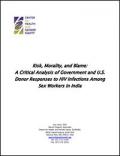Publications - Released in 2004
India is one of five countries that—along with Russia, China, Nigeria and Ethiopia—were classified by the U.S. National Intelligence Council in 2002 as representing the second wave of the HIV/AIDS epidemic. Current estimates put the total of those infected with HIV in India at 4.5 million, with projections for the number of infections to rise to anywhere between 9 to 25 million by 2010 (NACO 2003; NIC 2002; Rao 2003). Mirroring the global trend, new infections in India are rising rapidly among women ages 15 to 49, who, in 2002, accounted for nearly 40 percent of the total number of estimated cases in the country (NACO Director, July 25, 2003). Surveillance data indicate that HIV prevalence rates among women attending antenatal clinics in several Indian states are well above one percent (NACO 2003). As is clear from these data, HIV infections in India have moved from “high-risk” populations, such as commercial sex workers, into the general population. Yet, not surprisingly, sex workers remain disproportionately affected by the epidemic in India, with prevalence rates among them ranging from 40 to 60 percent in some parts of the country.






